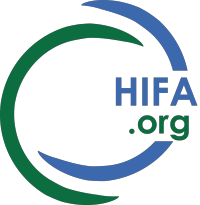Thanks to Fatima Suleiman [ https://www.hifa.org/dgroups-rss/support-systems-12-q3-can-you-share-exa... ] for highlighting the Treatment Action Campaign's role in health policy in Sounth Africa, as described by the paper:
Mark Heywood, South Africa's Treatment Action Campaign: Combining Law and Social Mobilization to Realize the Right to Health, Journal of Human Rights Practice, Volume 1, Issue 1, March 2009, Pages 14–36, https://doi.org/10.1093/jhuman/hun006
It shows how TAC has succcessfully used 'a combination of human rights education, HIV treatment literacy, demonstration, and litigation'. The production, identification and application of 'evidence' is not explicitly described, although clearly their work has involved fact-finding, analysis and reference to South Africa's own constitution. Perhaps the most powerful use of 'evidence' with TAC has been through treatment literacy: 'The model that was adopted came from the United States, where AIDS activists, led by people with HIV, had pioneered the idea of ‘treatment literacy’ among people with HIV. Treatment literacy recognizes that in order to fight for rights effectively, people also are required to understand the science of HIV, what it was doing to their body, the medicines that might work against it, the research that was needed etc. Emulating this model, TAC became the first AIDS activist organization to pioneer the concept and practice of HIV ‘treatment literacy’ in a developing country.'
Here the strength is not in producing new evidence, but in empowering people with existing evidence. And empowerment can be enabled with healthcare information that would be described as basic by health researchers. (In the same way, failure to provide timely, simple, lifesaving treatments are so often due to lack of basic healthcare information.)
Below are some extracts from the paper and a comment from me.
EXTRACTS
'Treatment literacy is the base for both self-help and social mobilization. Armed with proper knowledge about HIV, poor people can become their own advocates, personally and socially empowered.'
'At its best the TAC model did two things: it created a national social mobilization capable of unifying people to demand the right to health from government and pharmaceutical companies and it created an empowered citizenry at a local level who assisted and demanded the delivery of healthcare services within poor communities as a matter of right and law.'
'TAC's first campaign, launched on 10 December 1998, was intended to be tangible, understandable, emotive, and life saving. It was to demand that the South African Government introduce a national programme to prevent mother-to-child HIV transmission (PMTCT)... TAC argued that profiteering by GlaxoSmithKline (GSK), the patent holder of AZT, from an essential medicine was a violation of the right to life – and demanded a price reduction.'
'TAC made a study of law and worked closely with progressive lawyers, many of whom developed their skills in using the law to undermine apartheid. TAC argued that the Constitution created a legal duty on the government to fulfil its human rights provisions.'
'The ultimate objective of human rights campaigners is a more and more empowered citizenry, living in a context of globally agreed and nationally accepted rights, and within reach of a broad range of legal systems to enforce them.'
COMMENT: This case study certainly provides a good example of "Q3 Can you share examples of the role of civil society organisations in health policymaking at national or sub-national levels?" The use of 'evidence' includes making a legal case for policy change on the basis of existing legislation, and of raising awareness among the general public about healthcare and their right to medicines and services. Doubtless the campaign also used the evidence of personal testimony.
It would be interesting to hear the perspective of health policymakers who were working at the time time of TAC's actions. Some of them may have resisted change, while others may have assisted it. What were the key factors that drove change, from their perspective?
We look forward to hear about other examples where civil society organisations have used evidence to influence national, subnational or local health decision-making.
Please email: hifa@hifaforums.org
Best wishes, Neil
Joint Coordinator, HIFA SUPPORT-SYSTEMS
https://www.hifa.org/projects/new-support-systems-how-can-decision-makin...
Let's build a future where every person has access to reliable healthcare information and is protected from misinformation - Join HIFA: www.hifa.org
HIFA profile: Neil Pakenham-Walsh is global coordinator of the HIFA global health movement (Healthcare Information For All - www.hifa.org ), a global community with more than 20,000 members in 180 countries, interacting on six global forums in four languages in official relations with WHO. HIFA brings stakeholders together to accelerate progress towards universal access to reliable healthcare information.
Twitter: @hifa_org neil@hifa.org
Join HIFA: www.hifa.org/joinhifa
Join CHIFA (child health and rights): http://www.hifa.org/joinchifa
Join HIFA-Portuguese: http://www.hifa.org/join/junte-se-ao-hifa-portuguese
Join HIFA-French: http://www.hifa.org/join/rejoignez-hifa-francais
Join HIFA-Spanish: http://www.hifa.org/join/unase-hifa-espanol
Join HIFA-Zambia: http://www.hifa.org/join/join-hifa-zambia
Hifa-fr@dgroups.org
Hifa-pt@dgroups.org
HIFA-es@dgroups.org
Joint Coordinator, HIFA Communicating health research
https://www.hifa.org/projects/new-communicating-health-research-support-...
Joint Coordinator, HIFA mHEALTH-INNOVATE
https://www.hifa.org/dgroups-rss/mhealth-innovate-1-what-can-we-learn-he...

